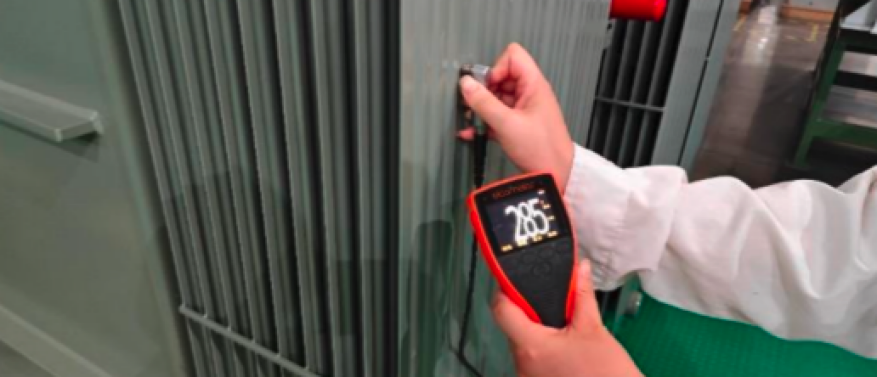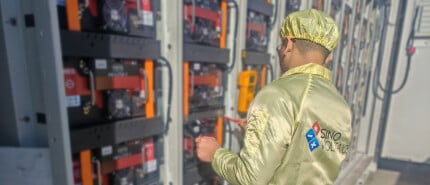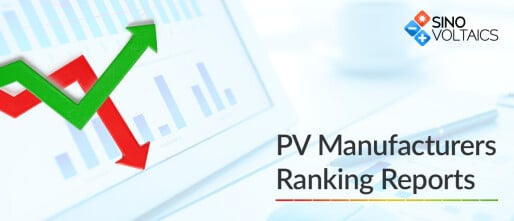This article features content extracted from a webinar co-hosted by Sinovoltaics and volytica diagnostics GmbH. To revisit the webinar, click on the link below:

FAT as in Body fat? Far from it. We are talking about the Factory Acceptance Test. And here in this article, we are talking about FAT for BESS - Battery Energy Storage Systems only.
Why is FAT Important for BESS?
There are multiple reasons why the FAT (Factory Acceptance Test) is important in this context.
(a) Avoid Bad Publicity-Fires. Let’s be honest, the risk of an actual battery fire is quite low, but those are costly. Even a small incidence of fire with no significant damage will cause very bad publicity due to the vibrant media. An example is the fire that broke out at the 139MW Terra-Gen Valley Center Energy Storage Facility in San Diego County, California on 18 September, 2023). The incident caused such scare that surrounding roads were closed, residences in the neighborhood were alerted for evacuation and a high school was opened in the evening to act as a temporary. But headlines like “Tesla Megapak battery ignites after less than 6 months” were splashed all over the media.
Unfortunately, these media stories remain on the internet forever and put a very visible question mark on the reputation.
(b) Return on Investment (ROI). BESS underperformance will most likely cause a decommissioning of at least a part of the system. That affects the ROI. In the case of the fire incident at Valley Center Project, many containers had to be shut down. Now, this facility should produce enough electricity to power up to 140,000 homes for four hours on a single charge and has secured long-term power purchase agreements with San Diego Gas & Electric. Think of the financial loss in addition to the loss of reputation!
Any Relevant Standards for FAT?
There are no standards defined for FAT. UL 9540 and UL 9540A are only applicable to the design phase of BESS. Since there are no standards, everyone can make their own tests. Each supplier has his own QA testing list and even the same supplier may have two different QA test lists for two different clients depending on their requirements. So, ultimately, it depends on the final client.
Another factor that may squeeze FAT is unscheduled delays and the rush to push the order out. That may leave limited time for conducting FAT testing thoroughly.
What is included in FAT?
Sinovoltaics Inspection has set its own standards for conducting FAT. A FAT by Sinovoltaics will include:
(a) Visual inspection.
(b) Component measurements.
(c) BESS Integration.
(d) Performance test.
Some Usual Observations During FAT
(a) Visuals and Aesthetics:
1. Shabby visuals
2. Drab, bad, or broken paint.
3. Broken or loose knobs and handles
4. Dented, cracked casing- This indicates possibly serious damage inside
5. Wrong company labels / wrong spelling printed on equipment.
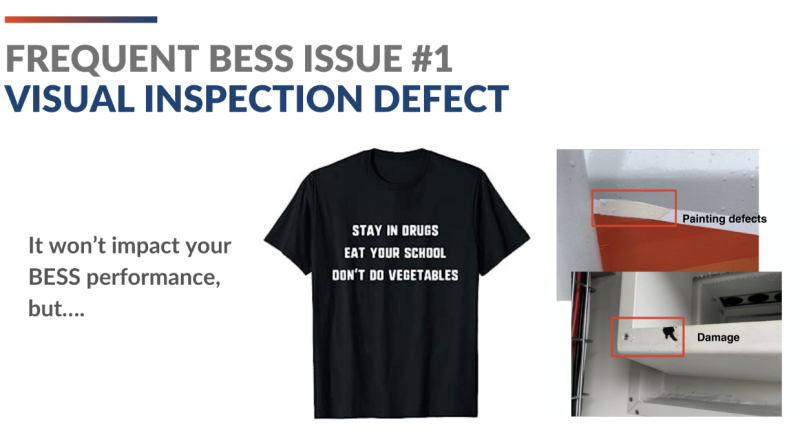 Figure 1: illustrates some examples.
Figure 1: illustrates some examples.
(b) Operational:
1. In one-third of the Inspections carried out by Sinovoltaics, they have found the Fire Safety System defective. That is a very dangerous trend.
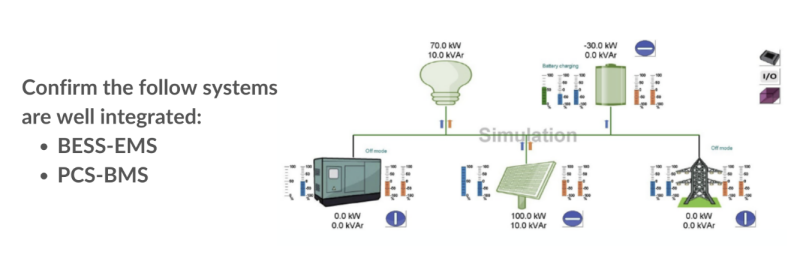 Figure 2: System software Integration is Important
Figure 2: System software Integration is Important
2. Software issues - Cooperation of BESS with other systems will have bugs. (Figure 2). Unfortunately, the removal of software bugs tends to leave little time for thorough FAT checks. Make sure the integration of BESS to EMS: how the BESS will work with the solar panels, with the genset, the grid, and the load. And you want to be sure that those tests are done before the FAT. Similarly, the inspection must ensure that cooperation between BMS (battery management system) and PCS (power control system: inverter and grid) is OK.
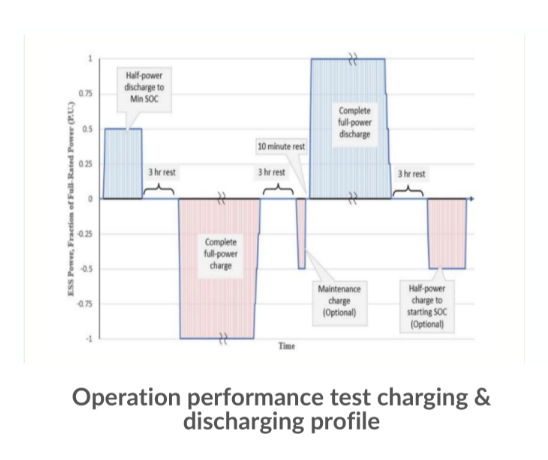 Figure 3: Performance Test
Figure 3: Performance Test
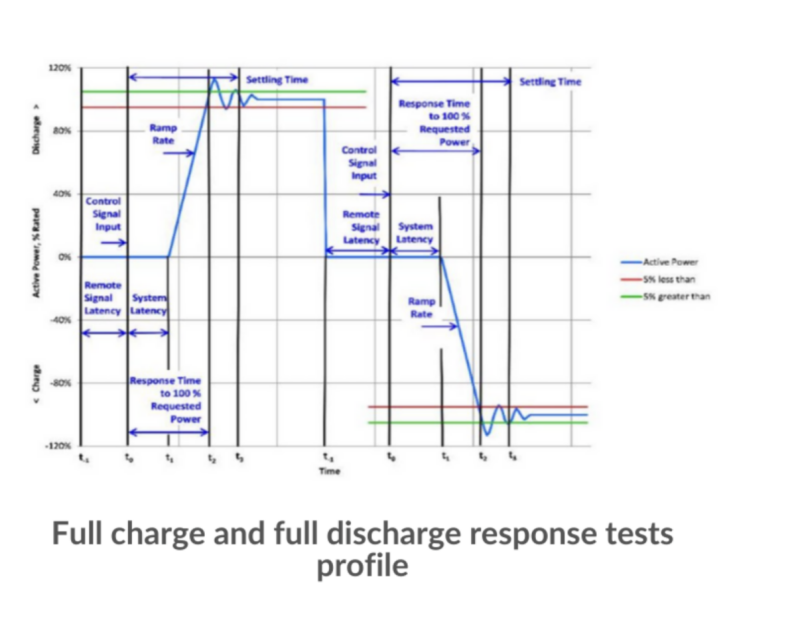 Figure 4: Systems must be loaded fully
Figure 4: Systems must be loaded fully
3. BESS Performance Test fails - BESS Performance Test fails - Sinovoltaics loads the system up to the full specs to check the performance. When systems were loaded many times, the system failed to perform at many times.
Points to Remember about FAT
(a) BESS tests must be predetermined early and preferably made part of the supplier contract.
(b) Tests must be performed under specified worst-case (quality testing) conditions including temperature, C-rate, humidity, etc. Figure 5.
(c) Tests should be witnessed by your rep onsite.
(d) The interface between various parts of the Control software must be tested before the FAT.
BESS Testing in Operation
Not all defects can be found in FAT at the factory. Faults and degradation will occur also during operation. volytica diagnostics, an offshoot of the Fraunhofer Institute, has developed effective software for testing the BESS in detail during operation.
The volytica VDX Engine
Every battery system will have means to measure and record the voltage, current, and power. The data is stored, often in the cloud by the manufacturer or by the owner of the plant. However, they do not always analyze it systematically and continuously. That requires specialist software. The volytica diagnostics, VDX, has been designed to do just that. (Figure 5). VDX does not need to install any additional hardware. It uses whatever is already there. It is not necessary to monitor individual cells. Typically, it monitors the hottest and the coolest cells, and the ones with the highest and lowest voltage. Generally, the sampling is at a rate close to one per second.
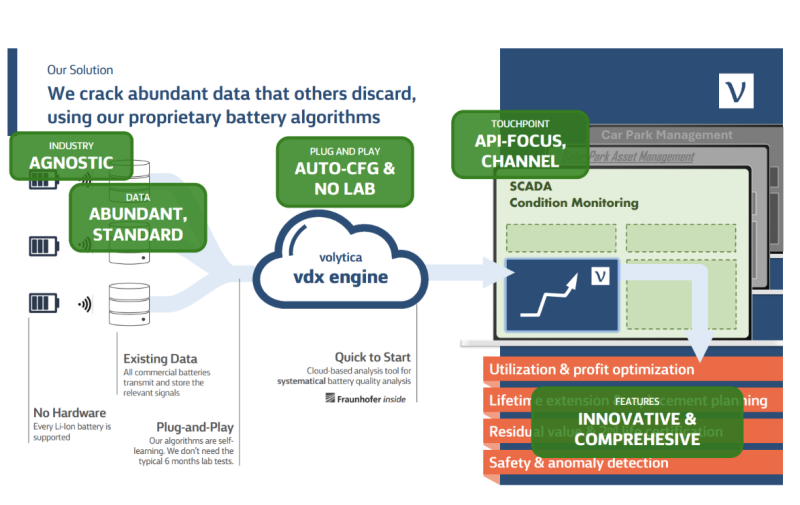 Figure 5: VDX Interface (SCADA interface soon)
Figure 5: VDX Interface (SCADA interface soon)
The following aspects are targeted.
(a) Cell and component failures - Abnormal electrical behavior that can be correlated to cell or cell-periphery failures.
(b) Cell balancing issues - Disbalanced battery cells inevitably lead to system downtime when undetected – particularly, slow trends remain unnoticed by local electronics. Continuous analysis of system balance can give an alert on critical situations.
(c) Subsystem performance spread - Performance spread will cause uneven load distribution on some subsystems, leading to early failure.
(d) Thermal anomalies and trends can be critical – the software analyses temperature trends, deviations, and abnormal behavior of the cooling/heating.
What Does VDX Give
Using the raw data on current, voltage, and temperature readings, VDX generates information about profit optimization. It leads to information on:
(a) How can the BESS operation be optimized?
(b) How can the lifetime of a battery be extended?
(c) What is the degradation level of the cells?
(d) When do I have to really replace it- at the end of the warranty, or can I use it a bit longer?
(e) Residual Value Certification is very important when a whole farm of batteries gets sold or resold. The buyer needs to assess the price based on the residual value of a used system.
(f) Safety and anomaly detection.
(g) Warnings and alerts are also sent out via email.
(h) Information on the stress level of the battery.
(i) Is the usage condition more stressful or less stressful than initially planned?
(j) Can it be pushed a little bit to the limits?
(k) Battery health reports- PDF reports with very detailed analysis of:
a. The state of health (SOH)
b. Residual capacity
c. Round trip efficiency
d. Safety issues
e. Other statistics
The Lithium-ion Battery
There are three main types of lithium-ion batteries in the energy world. Figure 6.
(a) NMC, Nickel-Manganese-Cobalt lithium-ion batteries which have dominated the field in the past for both automotive and stationary use.
(b) LFP, Lithium Iron Phosphate (with kind of a renaissance in the last few years).
(c) And then there are also exotic types like LTO, titanate, solid state, etc.
 Figure 6: Lithium Battery types
Figure 6: Lithium Battery types
The NMC Battery
Various chemistries are possible for NMC lithium-ion batteries, but all contain some nickel. They have quite a high energy density and a mediocre lifetime and safety. The energy density is continuously being increased but at the cost of some safety and lifetime, which are being compromised. Their cost is high.
Despite the high cost and decreasing lifetime, the NMC is the standard for the automotive industry because they are not concerned as much with battery life as with range. Higher capacity provides a higher range.
Lithium Iron Phosphate
Lithium iron phosphate (LiFePO4 or LFP) cells are becoming more popular. Although they don't pack as much energy as nickel cells, they last longer and are sturdier. They used to be cheaper, especially since they're mainly from China and are pretty much standard there. However, it's not certain that LFP will completely take over the future because they do have some downsides.
Other Types
Other exotic chemistries also exist or are in the pipeline like Lithium Titanate (LTO), Lithium-Air, Lithium-Sulphur, and Sodium Ion (Not in the lithium family) and the solid-state battery. The Solid-state battery differs in that the electrolyte has been replaced by something else. We cannot predict its future yet except that it will not find ground in the next five years. Other exotic forms have electronics sensors and IOT etc. but are limited to small systems like one kilowatt-hour compared to a Tesla, which is roughly 100 kilowatt hours.
Battery Cycle and State of Charge
Whatever the type of cell, all battery systems large or small are made up of battery cells. And unfortunately, those cells degrade. To understand the degradation mechanism, we need to look at some basics of the battery charge-discharge cycle.
State of charge (SOC) means how full the battery is at a given moment. SOC window is the two levels between which the battery normally charges and discharges.
The usage profile is characterized by:
(a) The temperature profile,
(b) The current profile, and by
(c) The way you operate the SOC (your charge /discharge profile).
Battery Life
Battery life depends, as we will see later, on usage conditions (Figure 7):
(a) Temperature,
(b) SOC window being used (even when not in operation the state of charge matters),
(c) Power during operation, and
(d) Charging conditions.
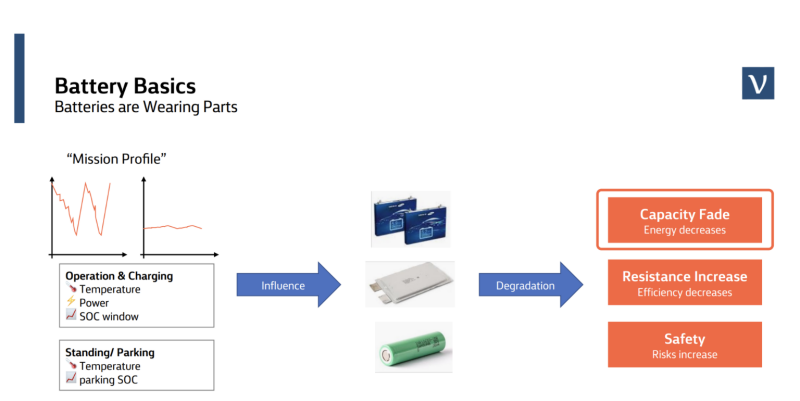 Figure 7: Battery Degradation
Figure 7: Battery Degradation
Battery degradation has three elements:
(a) The capacity reduces (capacity fade) leading to reduced energy storage,
(b) Battery resistance increases leading to reduced efficiency, and
(c) Battery safety risks increase.
Please see Figure 4.
Capacity Fade
To look at capacity fade we investigate a battery cell. A cell has two plates: the positive, and the negative, immersed in a liquid called the electrolyte and separated by a separator. Figure 8. Ions travel between the positive and the negative poles back and forth, charging and discharging all the time. However, a small fraction of ions act chemically with the electrolyte and form a passive residue on the plate surface (often called Solid Electrolyte Interface-SEI). Along with the battery life, some ions interact to produce metallic lithium which is also deposited on the SEI. This is called lithium plating. The effective plate area is thus reduced. The ions are no longer available for current transport action (like casualties or deserters in wartime). Battery capacity fades because of both these effects (Area reduction, and ion loss).
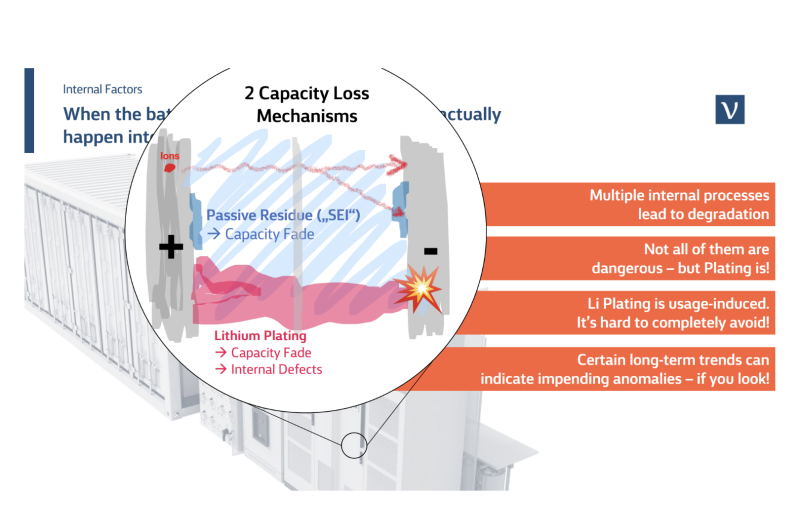 Figure 8: How does it Lose capacity?
Figure 8: How does it Lose capacity?
What Affects the Degradation Rate?
Multiple complex chemical reactions take place in the cell. The speed and extent of these reactions depend again on multiple factors and the dependencies are quite complex. Figure 9 is a very simplified sketch of how these factors influence power fade, range fade (in the case of vehicle batteries), and safety.
 Figure 9: Factors Affecting rate of Battery Degradation
Figure 9: Factors Affecting rate of Battery Degradation
Effect of Temperature and Fire Hazard
In general, temperature promotes chemical action. Batteries operated at low temperatures deplete faster and have reduced life. Figure 10 shows the effect of operating temperature on the life of batteries in a few charge-discharge cycles. Cooling must be provided in all battery systems to avoid fires and to reduce degradation due to temperature. Liquid cooling can extract heat more uniformly, but whether air cooling or liquid cooling, is really a design issue. However, when packing is dense liquid cooling may provide more uniform cooling avoiding local hot spots.
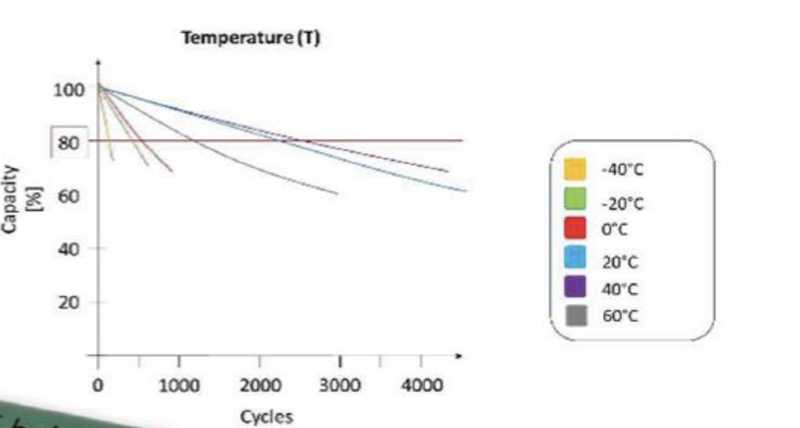 Figure 10: Effect of Temperature on Battery Life
Figure 10: Effect of Temperature on Battery Life
Fire Hazard
Overheating may ultimately cause a fire. Usually, it is the external systems, including cables and connectors, etc., which start a fire. Once started, for whatever reason, fires can cause huge damage and bad publicity.
Effect of SOC Window Shift
Figure 11 shows the effect of the SOC window shift. Three identical battery cells labeled yellow, green, and red in the picture were used under different conditions. The yellow one was cycled between 70% and 10% SOC, the green one between 80% and 20%, while the red one was cycled between 90% and 30%. In each case the swing was 60%, but in different windows. The impact on degradation is amazing.
Reduction of capacity down to 80% is currently considered by the industry as end-of-life. The red sample, operating between 90% and 30% reached a state of 80% capacity in 2000 cycles, but the one that was cycled between 70% and 10% (the same swing but under different conditions), lived almost twice as long. The influence of usage conditions on lifetime is massive.
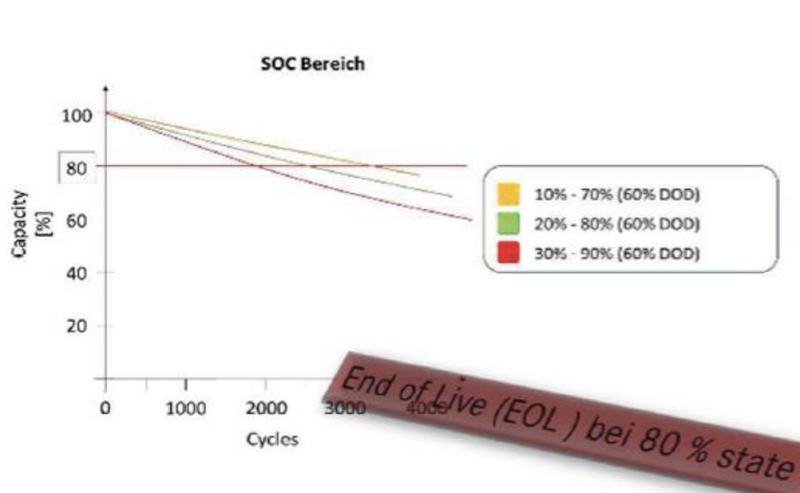 Figure 11: Effect of SOC Window Shift
Figure 11: Effect of SOC Window Shift
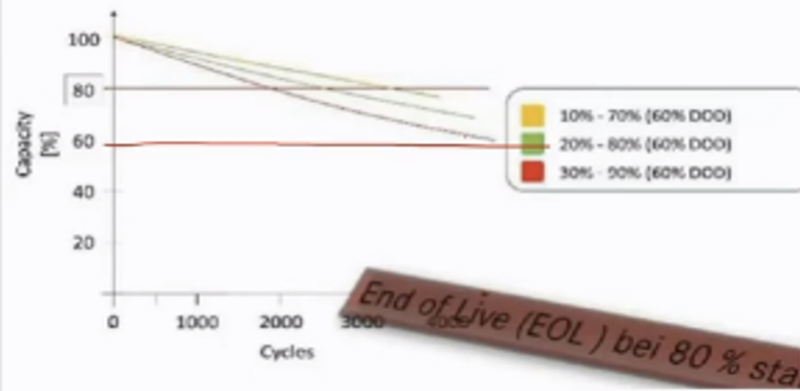 Figure 12: Effect of Idle SOC
Figure 12: Effect of Idle SOC
Effect of Idle SOC
The state of charge matters to the life of an idle battery. In an experiment battery A was allowed to stand idle with 100% charge, battery B with 80%, and battery C with 50% charge. Figure 8 Battery A lived only 800 days (assuming 80% capacity as the end of life), battery B lived more than 1500 days, and battery C lived on for more than 4000 days. So, idle batteries will have a longer life if kept at a lower SOC.
 Figure 13: Effect of Rate of charge/Discharge
Figure 13: Effect of Rate of charge/Discharge
Rate of Charge/Discharge
As is commonly understood, fast charging/ discharging harms the life of the battery. In Figure 13 a battery that has a life of 300 cycles when operated at 1C, gives a life of over 4000 cycles when operated at 0.75 C and even longer at lower current rates. Higher C rates cause a higher rate of degradation which at some stage, causes a Stress-Induced Onset of much faster degradation. Figures 14 and 15.
 Figure 14: Stress Induced Onset of Faster Degradation
Figure 14: Stress Induced Onset of Faster Degradation
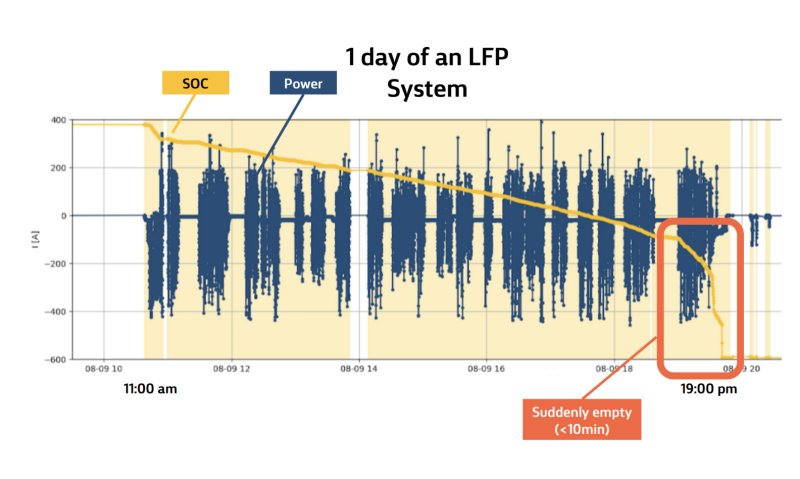 Figure 15: One Day of an LFP system
Figure 15: One Day of an LFP system
End of Warranty or End of Life?
Now we should differentiate between “end of warranty” and “end of life”. To minimize the number of warranty claims manufacturers, produce batteries so that they can be reasonably expected to live beyond the guaranteed life. Thus, when the warranty of a battery expires, the battery may have still more capacity than what was guaranteed (usually 80%). So, even if 80% is taken as end-of-life most batteries are not dead at the end of the warranty period. They can still be used. This is just like yogurt and pizza which normally live longer than the “best before” date. This indicates there is scope for extension of life.
End of Life Criteria
80% capacity has been taken as standard for end of life as far as warranty is concerned. But it is not going to remain so. Companies are going for 70% or even 60%. There is no hard and fast rule. See Figure 16.
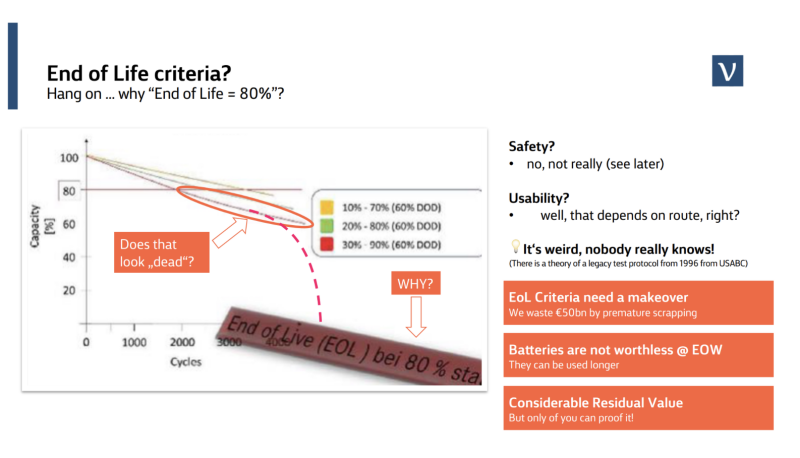 Figure 16: Changing Criteria-End of Life
Figure 16: Changing Criteria-End of Life
Estimation of Residual Value
So, batteries have residual value even after the guaranteed life. But how much? This question is especially important when a new replacement is being planned or used systems are being purchased. How can we make a good estimate of the residual value of the battery system? There are systems like volytica EDX that can make an intelligent estimate of the residual value of a BESS by monitoring a BESS automatically and in detail.
A Korean BESS Study
A study has reported that approximately 2% of all Korean BESS systems encountered fire issues between 2017 and 2022. Figure 17 This is a small figure. But the economic impact was a loss of up to 750 million euros! It was further reported that 90% of the cases could have been avoided with proper FAT, good engineering, inspection, and monitoring solutions. This is especially significant when battery temperature stability is being compromised for higher energy density.
 Figure 17: Korean Studyi
Figure 17: Korean Studyi
The Need for Inspection and Monitoring
The report also indicates that 90% of the incidents could have been avoided with proper FAT, and BESS monitoring, which means a proportionate amount of revenue could have been saved had there been proper inspections and monitoring. Specifically, FAT test inspections at early stages, like those performed by Sinovoltaics during manufacturing, pre-shipment, and onsite full-load performance tests before commissioning can eliminate most of the possible losses.
Thus, a proper BESS quality assurance plan to control the supply chain, already in the early stages of BESS procurement, including monitoring during manufacturing, and FAT will be important considerations for every BESS developer or Investor.



